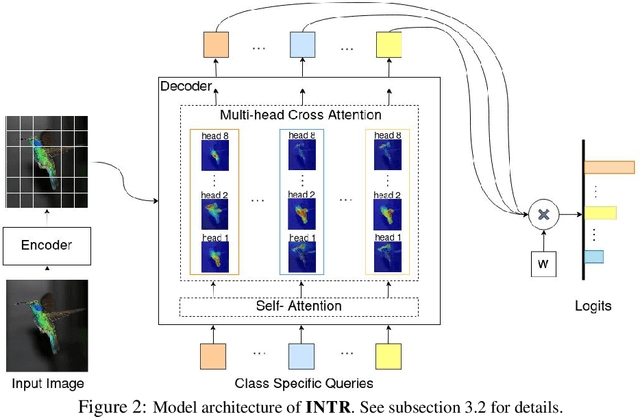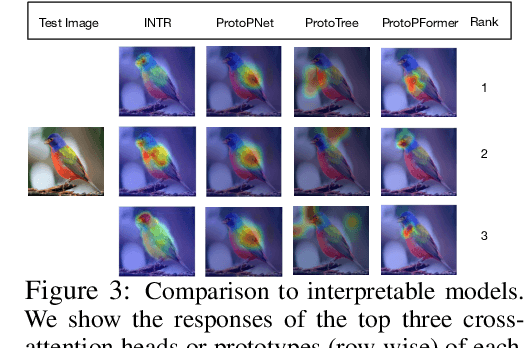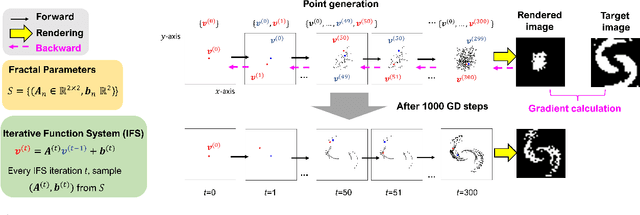David Carlyn
Finer-CAM: Spotting the Difference Reveals Finer Details for Visual Explanation
Jan 20, 2025



Abstract:Class activation map (CAM) has been widely used to highlight image regions that contribute to class predictions. Despite its simplicity and computational efficiency, CAM often struggles to identify discriminative regions that distinguish visually similar fine-grained classes. Prior efforts address this limitation by introducing more sophisticated explanation processes, but at the cost of extra complexity. In this paper, we propose Finer-CAM, a method that retains CAM's efficiency while achieving precise localization of discriminative regions. Our key insight is that the deficiency of CAM lies not in "how" it explains, but in "what" it explains}. Specifically, previous methods attempt to identify all cues contributing to the target class's logit value, which inadvertently also activates regions predictive of visually similar classes. By explicitly comparing the target class with similar classes and spotting their differences, Finer-CAM suppresses features shared with other classes and emphasizes the unique, discriminative details of the target class. Finer-CAM is easy to implement, compatible with various CAM methods, and can be extended to multi-modal models for accurate localization of specific concepts. Additionally, Finer-CAM allows adjustable comparison strength, enabling users to selectively highlight coarse object contours or fine discriminative details. Quantitatively, we show that masking out the top 5% of activated pixels by Finer-CAM results in a larger relative confidence drop compared to baselines. The source code and demo are available at https://github.com/Imageomics/Finer-CAM.
A Simple Interpretable Transformer for Fine-Grained Image Classification and Analysis
Nov 07, 2023



Abstract:We present a novel usage of Transformers to make image classification interpretable. Unlike mainstream classifiers that wait until the last fully-connected layer to incorporate class information to make predictions, we investigate a proactive approach, asking each class to search for itself in an image. We realize this idea via a Transformer encoder-decoder inspired by DEtection TRansformer (DETR). We learn ``class-specific'' queries (one for each class) as input to the decoder, enabling each class to localize its patterns in an image via cross-attention. We name our approach INterpretable TRansformer (INTR), which is fairly easy to implement and exhibits several compelling properties. We show that INTR intrinsically encourages each class to attend distinctively; the cross-attention weights thus provide a faithful interpretation of the prediction. Interestingly, via ``multi-head'' cross-attention, INTR could identify different ``attributes'' of a class, making it particularly suitable for fine-grained classification and analysis, which we demonstrate on eight datasets. Our code and pre-trained model are publicly accessible at https://github.com/Imageomics/INTR.
Discovering Novel Biological Traits From Images Using Phylogeny-Guided Neural Networks
Jun 05, 2023



Abstract:Discovering evolutionary traits that are heritable across species on the tree of life (also referred to as a phylogenetic tree) is of great interest to biologists to understand how organisms diversify and evolve. However, the measurement of traits is often a subjective and labor-intensive process, making trait discovery a highly label-scarce problem. We present a novel approach for discovering evolutionary traits directly from images without relying on trait labels. Our proposed approach, Phylo-NN, encodes the image of an organism into a sequence of quantized feature vectors -- or codes -- where different segments of the sequence capture evolutionary signals at varying ancestry levels in the phylogeny. We demonstrate the effectiveness of our approach in producing biologically meaningful results in a number of downstream tasks including species image generation and species-to-species image translation, using fish species as a target example.
Learning Fractals by Gradient Descent
Mar 14, 2023



Abstract:Fractals are geometric shapes that can display complex and self-similar patterns found in nature (e.g., clouds and plants). Recent works in visual recognition have leveraged this property to create random fractal images for model pre-training. In this paper, we study the inverse problem -- given a target image (not necessarily a fractal), we aim to generate a fractal image that looks like it. We propose a novel approach that learns the parameters underlying a fractal image via gradient descent. We show that our approach can find fractal parameters of high visual quality and be compatible with different loss functions, opening up several potentials, e.g., learning fractals for downstream tasks, scientific understanding, etc.
 Add to Chrome
Add to Chrome Add to Firefox
Add to Firefox Add to Edge
Add to Edge